Menus
- Winnetou and Old Shatterhand
- Chief Vintage almost identical to the original
- Wider, longer and above all 110 kilograms heavier
- Just don’t stall now!
- And the new one?
- Technical data Indian Chief from 1946
- Technical data Indian Chief Vintage
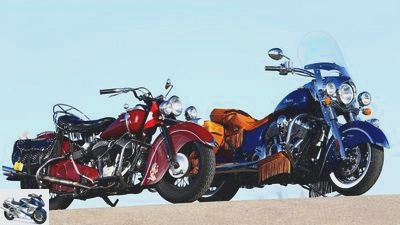
Gargolov
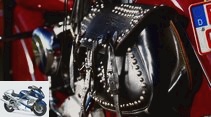
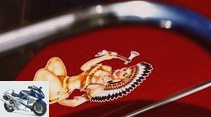
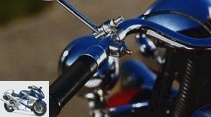
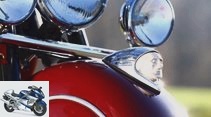
36 photos
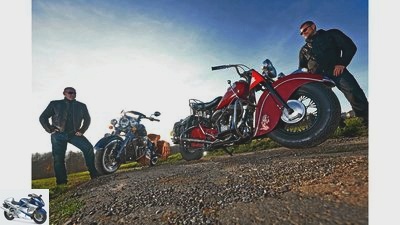
Gargolov
1/36
Resuscitation in the wigwam: Indian is back!
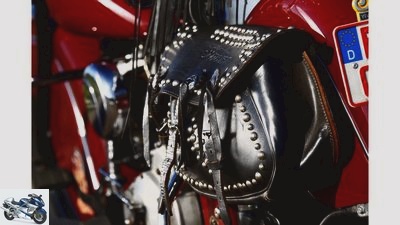
Gargolov
2/36
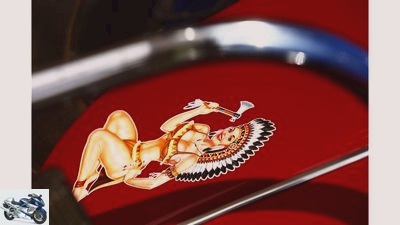
Gargolov
3/36
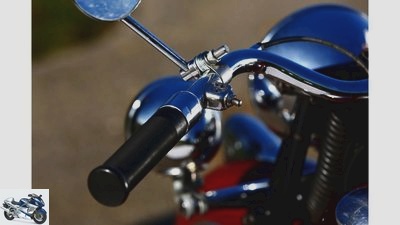
Gargolov
4/36
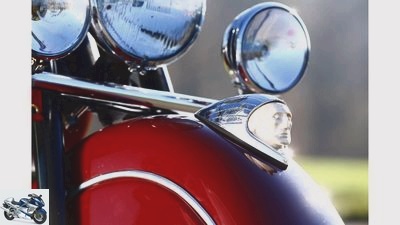
Gargolov
5/36
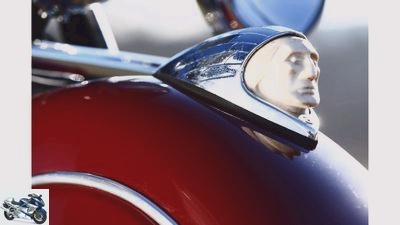
Gargolov
6/36
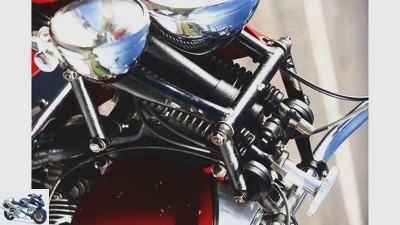
Gargolov
7/36
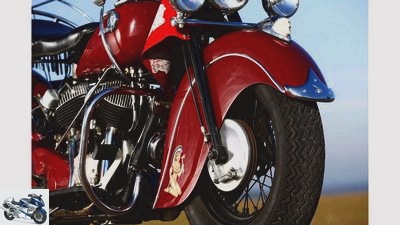
Gargolov
8/36
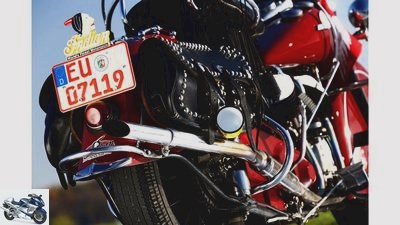
Gargolov
9/36
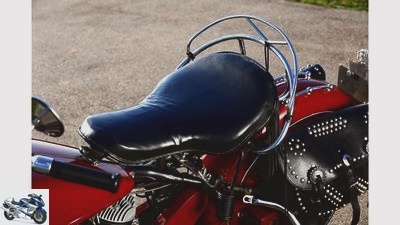
Gargolov
10/36
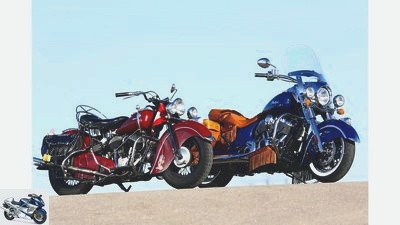
Gargolov
11/36
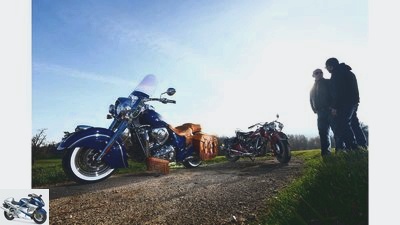
Gargolov
12/36
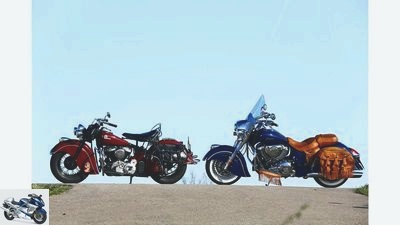
Gargolov
13/36
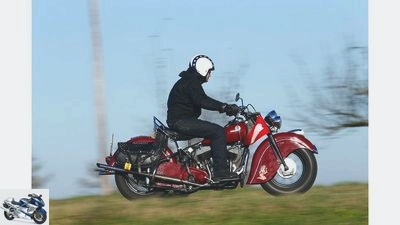
Gargolov
14/36
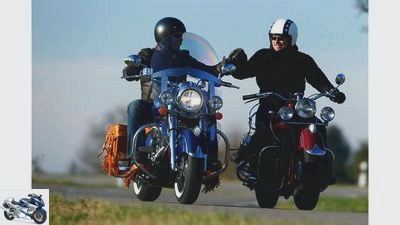
Gargolov
15/36
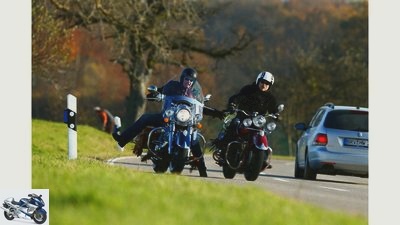
Gargolov
16/36
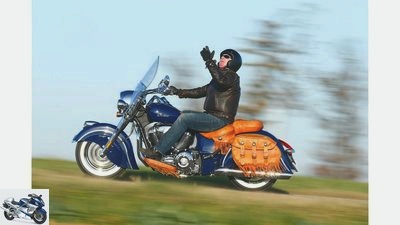
Gargolov
17/36
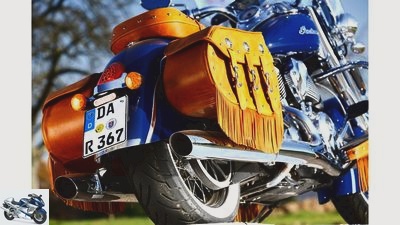
Gargolov
18/36
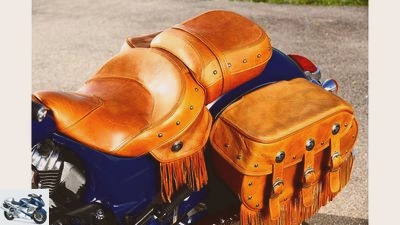
Gargolov
19/36
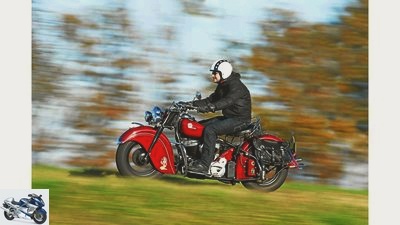
Gargolov
20/36
Every meter is a source of joy and a challenge at the same time: the throttle is on the left! That’s why old Indian drivers greet each other with their right hand!
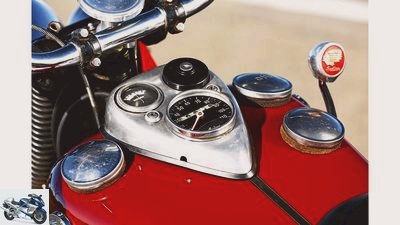
Gargolov
21/36
I am three tanks: main (left) and reserve tank plus oil reservoir for dry sump lubrication. Dashboard with ammeter, three-speed gear knob, parallelogram fork. cult!
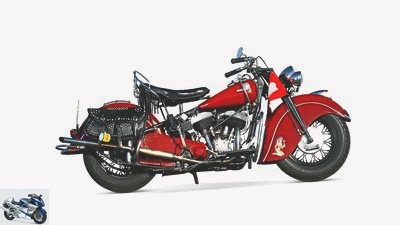
Gargolov
22/36
Forms of yesteryear that still inspire today. Huge fenders, high single seat, slim exhaust, almost petite 1200 V2.
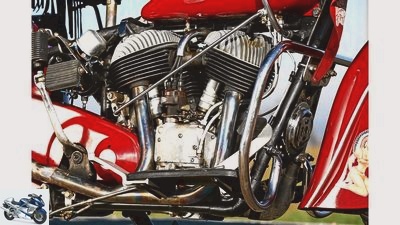
Gargolov
23/36
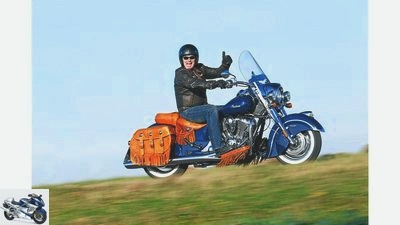
Gargolov
24/36
Lively: The huge Indian puts you in a great mood. Its operation is intuitive: the throttle grip on the right, conventional hand clutch on the left.
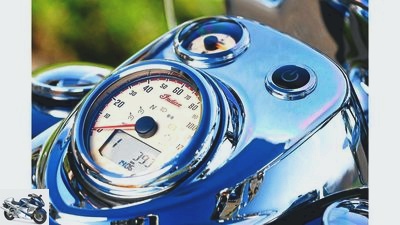
Gargolov
25/36
Bathed in chrome: huge, almost sober instrument panel with start button, fuel gauge and ivory-colored speedometer. In it, the gear indicator and tachometer display using liquid crystals.
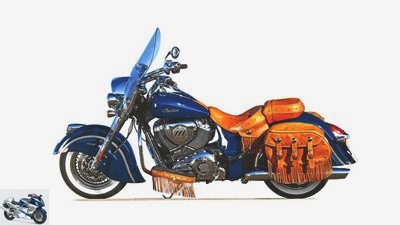
Gargolov
26/36
Unmistakable from the start. Whitewall tires, the finest leather and the citing of historical shapes set the tone. Fringes on the running boards cost extra.
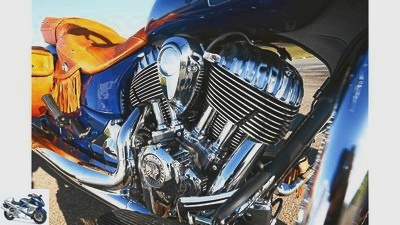
Gargolov
27/36
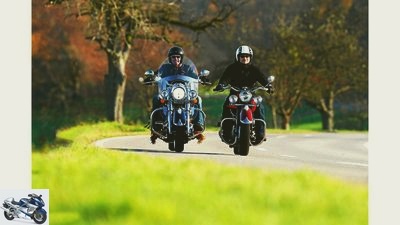
Gargolov
28/36
Opulent or original? The new Indian is quite original. And easier to drive than the more delicate classic car.
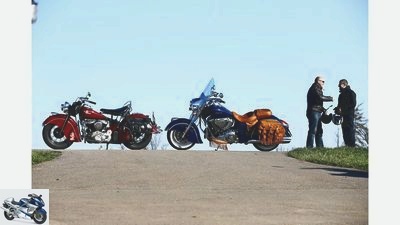
Gargolov
29/36
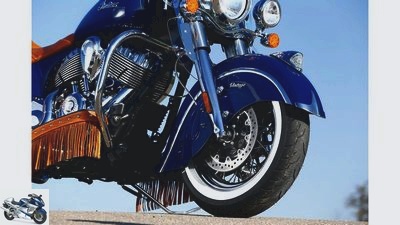
Gargolov
30/36
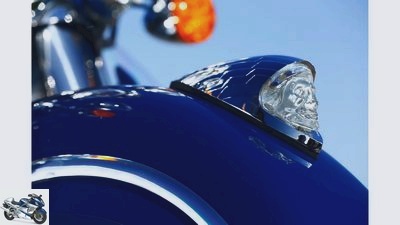
Gargolov
31/36
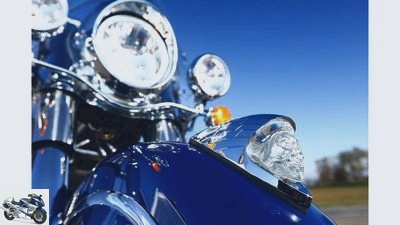
Gargolov
32/36
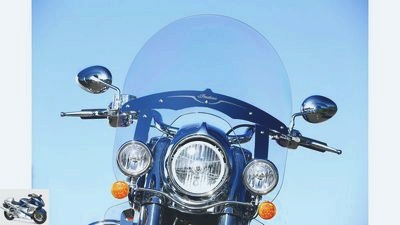
Gargolov
33/36
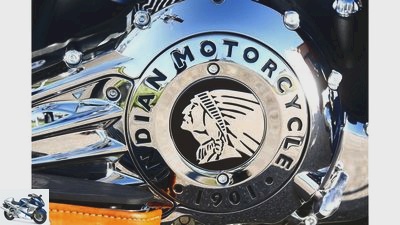
Gargolov
34/36
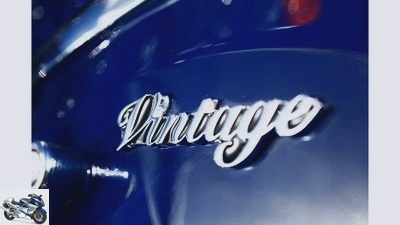
Gargolov
35/36

Gargolov
36/36
Indian Chief from 1946 and Indian Chief Vintage 2014 compared
Winnetou and Old Shatterhand
Indian is back! A dedicated development team quoted the ancestors of the oldest US motorcycle brand and brought them stylishly and carefully into the modern motorcycle era. This shows the encounter between a 1946 Indian Chief and a Chief Vintage from 2014.
Many fans have been looking forward to this moment longer than 30 years ago when “Winnetou” and “Old Shatterhand” were broadcast with Pierre Brice and Lex Barker: I.ndian is back! One of the most illustrious names in motorcycle history. A myth fueled by many images in the head. “Quite a few, and by no means only American motorcycle enthusiasts, consider the classic Indians (and that includes practically every Scout or Chief series) to be the most beautiful motorcycles that have ever been built.” This is how Indian expert Jerry Hatfield says in the preface of his out of print book “Indian im Bild”.
Buy complete article
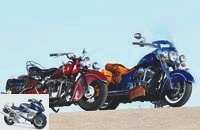
Indian Chief from 1946 and Indian Chief Vintage 2014 compared
Winnetou and Old Shatterhand
A driving machine with an honest patina
Perhaps the very early death contributed to the myth. In addition, there are Indian’s characteristic, style-defining fenders – mudguards is too mundane a word for that. It was not until 1940 (together with the straight travel suspension on the rear wheel) that the huge, aesthetically defining wheel covers appeared in Art Deco style. Inspired by the streamlined shape of the US automobiles of the time. This design has burned itself under the top of the skull.
Motorcycle enthusiasts from all over the world have kept the legend alive for 60 years. People like Werner Zull from Kall in the Eifel. The 53-year-old kindly lent us his Chief from 1946. Thanks for that! Werner has a lot of motorcycles, such as beautiful Ducatis. He “always felt a love for Indian”, bought the original operating instructions from a Chief when he was 18. Cult or intuition? This post-war red skin only found him in 2006, freshly imported from America. A driving machine with an honest patina, not just an exhibit. The Eifeler saddles his chief when he drives to meetings of the Indian Motocycle Club (www.indianclub.de) with its 450 members: “The condition is that you travel on your own.
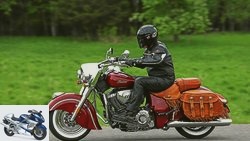
Chopper / cruiser
Indian Chief and Indian Chieftain in the driving report
The new chiefs among the cruisers?
read more
Chief Vintage almost identical to the original
In the next year there is guaranteed to be a lot to talk about around the campfire. Will they add the new 1800s to their tribe? Do they still have the spirit of the original Indians? Do they breathe the same old spirit? Are the completely newly constructed Indians also venerable iron horses? Do flesh and blood feel different, sorry: steel and iron feel different? “So far we have seen many new Indians come and go,” says Werner. But already as well-made as this Chief Vintage with leather panniers and glass?
Well, of all the attempts at resuscitation over the past six decades, this is certainly the most serious. The specially assigned development team of the motorcycle manufacturer Victory manages a balancing act. To combine modern technology with a feeling for the right shapes and the right proportions. It starts with the wonderfully curved front fender. Curved railings on the sides and the anchor-shaped application at the top seem to be congruent with the historical model. Nearly. Because the new metal mudguards are wider. Today’s Indians live on big feet, on 130 and 180 moccasins. 16-inch spoked wheels were just as much a part of good form then as they are today.
Wider, longer and above all 110 kilograms heavier
Beautiful: the illuminated Indian head on the front fender, a sign of the past and future. The next parallel sits one floor higher: one main headlight each, flanked by two switchable additional lights. Viewed from the side, the tanks appear triangular with a straight bottom edge. Today’s fuel drum is more bulky than the entire motorcycle. It also holds a generous 20.8 liters of fire water. The oldtimer has three tanks: the main tank is on the left, the oil tank for the dry sump lubrication at the front right and the reserve tank at the rear right.
The new one has two lids on the fuel tank, the left one is a dummy. Then as now, the instruments sit on top as fat dashboards. Once with an ammeter, today with a fuel gauge and LCD on-board computer. Basis and basic shapes for leather panniers with rivet fittings, climbing and pardon: crash bars and fringed saddles were donated by the ancestor. Only the high vantage point from back then gave way to a deep, wide cowboy saddle made of the finest buffalo leather. There is also more storage space today. A rolling bow to the past signifies the reinterpretation. Even if on a scale of 1.2: 1. Because it is wider, longer and, above all, 110 kilograms heavier. Soberly one would have to say: 390 kilograms are simply too much of a good thing for an air-cooled V2 cruiser.
Gargolov
Lively: The huge Indian puts you in a great mood. It is intuitive to use: the throttle grip on the right, conventional hand clutch on the left.
The historic Chief, a real big bike in 1946, pushes and maneuvers around worlds easier. Uff. With which the steel souls of the machines bring their hearts into focus. The 1200 V2 with cast iron cylinders and liners looks downright graceful next to the 1800. Its basic design dates from 1920, revised in 1937. The valves on the right-hand side widen the cylinders, giving the characteristic floor plan. The elbows plunge down from the heads practically vertically. There are many fine cooling fins on the cast light metal cylinder covers. Tall and narrow, they give the engine its unmistakable, irokesen-like look. The new V2 even follows these iconic shapes. Just bigger, wider, more powerful. Traditionally air-cooled, its chrome-plated valve covers are clumsier, with cooling fins as thick as a finger.
What a cathedral of a V2 engine, this 1800s! Indian did not take over any screw for the new “Thunder Stroke 111 engine”. Truly a clap of thunder. Its 111 cubic inches correspond to a full metric 1811 cm3. That is 50 percent more than the 1207 cm3 (74 cubic inches) of the ancestor. Skilful manifold guidance visually emphasizes the modern four bumpers better. They are parallel per cylinder. The middle of the three camshafts below actuates the individual intake valves of each cylinder. The ancestor had two camshafts below. Precision mechanics once: only one cam actuates both roller rocker arms for the valve train. Easy to care for today: maintenance-free hydraulic valve lifters. Once the cylinders were spread by 42 degrees, today by 49. Large 54-millimeter throttle valves take up more space than the 31.8-mm Linkert carburettor on the Y-shaped intake manifold from 1946. More bore also takes up space – a thick 101 -Holes instead of not slim 82.5 millimeters. There is a remarkable consensus about the hub: it has to be long. 113 millimeters today, 112.7 mm once. For a lot of feeling and steam from the bottom.
Just don’t stall now!
Bringing the oldie to life is an art, the start-up procedure a ritual in itself. The right twist grip regulates the ignition timing, gas is on the left handlebar end! The shift lever of the three-speed transmission, today there are twice as many gears, rises up on the right of the tank. So how was that again? Fuel tap open? Choke on the throttle valve carburetor all the way down? Now step through the kick starter three times without ignition current, gently get the V2 going. The kickstarter’s engagement mechanism sounds like a ratchet. Then place the choke in the middle of the five notches. Switch on battery ignition, ignition timing and gas at half opening. Fortunately, the handles keep the chosen position. Now it’s time to kick your left leg from the right side. With taste! Umpf. Nothing. Phew, it’s difficult, despite the low compression ratio of 5.5: 1. How does Werner Zull do it? Then a blow, an explosion. The 1.2-liter V2 runs, the legend trembles. The pencil-thin two-in-one exhaust crackles like machine gun barrels. The chief is on the warpath. He takes it literally. With smoke signals, blue clouds of oil. Just don’t stall now. Around the red skin again, board the high saddle, pull in the short side stand. Let’s go.
Wait a moment. The left foot kicks the clutch rocker forward. Engaging first gear means pushing the stick of the long shift linkage forward. At this moment you cannot activate either of the two toothless “quarter-hub drum brakes”. Let the clutch come on like in a car, not easy to dose, and – oops! – she drives! A great feeling. You have your hands full. Shifting up to second takes full concentration. The engine picks up momentum. Even the third one follows. Movement as an awesome phenomenon! What a challenge. Every turn or U-turn overwhelmed; Decades of classic conditioning are gone. Instead of turning off the gas, you turn the ignition to “late”, instead of shifting down, you clutch it. Left gas, stalled, great! Kick again, despair. At some point it will work. You watch the parallelogram fork at work, two coil springs plus oil pressure shock absorbers. You respond surprisingly fine. This fork was the identification mark of the 1946 Chief, taken over from the military machine 841. That fork had an atypically longitudinally installed V2 with cardan. In the 46 Chief, a chain drives the rear wheel and a belt drives the external alternator. But it is weakly tensioned, the ignition voltage drops. Brrrrtt, brrtt, brt. Off. That’s it. Just a few kilometers. But not to be surpassed in terms of experience density.
And the new one?
And the new one? It works much better in a purely rational way. The XXL-V2 hums gently from the thick exhausts laid on both sides, pushes well. Lots of little gimmicks help you drive: gasoline injection with automatic cold start enrichment, ABS, cruise control, easy-care toothed belts, smooth, hydraulically operated clutch. The land of the Apaches does not pass through the panoramic window, but the splendidly colored autumn leaves do. There’s an Indian summer behind the higher, wider handlebars! In addition, there is no draft behind the huge, easily removable pane. Only turning maneuvers require full concentration with a combat weight of 390 kilos and a turning circle of seven instead of five meters. At the price that the white man charges for his steel horses, you should first smoke a peace pipe: around 25,000 euros. Lots of wood. But good news: Winnetou and Old Shatterhand are back!
Technical data Indian Chief from 1946
Gargolov
Air-cooled 42 degree V2 four-stroke engine.
Air-cooled 42-degree V2 four-stroke engine, 1207 cm³, bore x stroke 82.5 x 112.7 mm, compression approx. 5.5: 1, approx. 23.5 kW (32 HP) at 3000 rpm, approx 80 Nm at 2400 rpm, single carburetor, two underlying camshafts, two stationary valves per cylinder, four bumpers, rocker arms, dry sump lubrication, kick starter, three-speed gearbox, mechanical foot clutch, tubular steel frame, parallelogram fork, two spring struts (straight-way suspension), 5.00 x tires 16, wheelbase 1549 mm, half-hub drum brakes front and rear, Ø 200 mm each, seat height 800 mm, tank capacity approx. 12 liters, weight 276 kilograms, length 2.45 meters, handlebar width / height 92/98 cm, turning circle 5.0 Meters, price approx. 25,000 euros.
Technical data Indian Chief Vintage
Gargolov
Air-cooled 49-degree V2 four-stroke engine.
Air-cooled 49-degree V2 four-stroke engine, 1811 cm³, bore x stroke 101 x 113 mm, compression 9.5: 1, 55 kW (75 PS) at 5075 / min, 139 Nm at 2600 / min, injection, three underlying camshafts, two hanging valves per cylinder, hydraulic valve lifters, bumpers, rocker arms, dry sump lubrication, electric starter, six-speed gearbox, hydr. Clutch, toothed belt, aluminum backbone frame, telescopic fork, Ø 46 mm, central spring strut with deflection, tires 130/90 B 16 and 180/65 B 16, wheelbase 1730 mm, double disc brake with four-piston fixed calipers at the front, disc brake. with two-piston fixed caliper at the rear, Ø 300 mm each, ABS, seat height 725 mm, 20.8 liter tank, weight 390 kg, length 2.62 meters, handlebar width / height 95/109 cm, turning circle 6.94 meters, Price 25 299 euros.
Related articles
-
Indian Chief Vintage in the 50,000 km endurance test
Gargolov 31 photos Gargolov 1/31 Froberg 2/31 All horses saddled? Tester Schwers lets the Vintage Chief gallop on the test bench during the input…
-
Harley-Davidson Heritage Softail Classic and Indian Chief Vintage put to the test
Gargolov 42 photos Gargolov 1/42 Gargolov 2/42 Its two tension struts work hidden under the gearbox, giving the Softail its rigid frame look. So the…
-
Indian models 2014 in the driving report
Manufacturer 30 pictures Indian 1/30 The new Indian models for 2014 could be tested exclusively by journalists from all over the world. Indian 2/30 The …
-
Indian Chief 2000 driving report
Indian Chief 2000 driving report Necromancy The longer the shadows of the past, the harder it is to start over. Indian dared anyway? and preserves old…
-
Indian Chief and Indian Chieftain in the driving report
Cathcart 26 pictures Wing 1/26 We took a closer look at the new models Chief and Chieftain from the oldest US motorcycle manufacturer Indian. Wing 2/26 …
-
Gargolov 50 photos Gargolov 1/50 The Yamaha XV 1900 A Midnight Star is the only one to brake without ABS, but with a composite system. Gargolov 2/50…
-
Indian Chief Classic from 2014 – Technical data
Indian Chief Classic technical data since 2014 Technical specifications engine Number of cylinders, type 2, engine power 62.0 kW / 84.3 hp at 4,500 rpm…
-
Indian Chief Vintage from 2014 – Technical data
Indian Chief Vintage Specifications since 2014 Technical specifications engine Number of cylinders, type 2, V-engine power 55.0 kW / 74.8 hp at 5075 rpm…
-
Harley-Davidson Electra Glide Ultra Limited and Indian Roadmaster in comparison
Gargolov 28 photos Gargolov 1/28 Harley-Davidson E-Glide Ultra Limited and Indian Roadmaster. Gargolov 2/28 … Electrically adjustable windshield, four…
-
Custom Bike Top Mountain Indian Bagger from Styrian Motor Cycle
Markus Krasser 12 pictures Markus Krasser 1/12 The conversion of Styrian Motor Cycle is based on an Indian Chief Vintage. Markus Krasser 2/12 The converted …